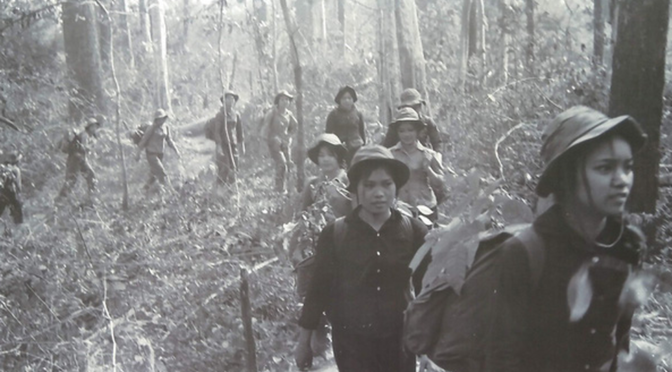
La journée se déroule en 2 temps : séminaire le matin et atelier l’après-midi.
9h30-12h, Séminaire de traductologie féministe
Intervenant : François Guillemot, historien spécialiste du Viêt Nam contemporain et ingénieur de recherche à l’IAO. Il viendra nous parler de son ouvrage Des Vietnamiennes dans la guerre civile. L’autre moitié de la guerre 1945-1975 paru en 2014 aux éditions Les Indes savantes.
Discutante : Léa Buatois (Agathe Senna). Normalienne de l’ENS de Lyon, ses recherches portent sur l’histoire de l’anarchisme chinois comme courant intellectuel au début du vingtième siècle et sur l’historiographie de ce mouvement en Chine, ainsi que sur l’émergence du féminisme chinois comme langage politique et ses rapports avec les rhétoriques nationalistes au début du vingtième siècle.
Résumé : L’émergence d’une connaissance académique sur le genre et la guerre au Viêt-Nam peut être datée de la fin des années 1990 lorsque le conflit régional avec le Cambodge se termine et que la politique de Renouveau culturel s’affirme. C’est à partir de cette décennie que des autrices et auteurs explorent l’histoire des Jeunesses de choc, une formation fondée en 1950 pour la logistique de guerre et mobilisée pendant les trois périodes de conflit (1950-1955, 1965-1975, 1979-1989). Formés de plus de 50% de jeunes femmes, ces groupements ont joué un rôle décisif dans la victoire communiste notamment sur la Piste Hô Chi Minh.
A la fin des années 2000, des initiatives sont prises par des chercheuses à Hô Chi Minh-Ville pour mener des investigations dans une perspective transnationale. Ainsi fut créé le groupe de recherche Gender And Society de l’université privée Hoa Sen, université dirigée par l’historienne Bui Tran Phuong, organisatrice d’un colloque international interdit par les autorités. Notre ouvrage sur « l’autre moitié de la guerre » s’inscrit dans ce contexte particulier et reflète précisément les difficultés qu’ont les témoins ou acteurs/actrices de cette guerre (écrivain·es, soldat·es, représentants politiques, corps médical …) à mettre des mots sur une guerre fratricide particulièrement destructrice lors de laquelle on a fait peu de cas du destin des femmes.
Cette difficulté à dire la vie quotidienne sur le théâtre des opérations militaires, à parler de la souffrance et de la brutalité de la guerre, se retrouve dans l’expression même du texte. Nous nous appuierons sur quelques exemples pour démontrer l’émergence du genre dans la littérature sur la guerre du Viêt-Nam et comment l’expression de l’indicible apparaît en filigrane dans certains textes d’écrivaines (Lê Minh Khuê, Duong Thu Huong, Vo Thi Hao) ou dans les études d’anciens responsables des Jeunesses de choc comme Nguyên Van Dê et Dông Sy Nguyên ou dans le témoignage du chirurgien Lê Cao Dai.
14h-16h. Atelier de traduction féministe
Emilie Fernandez présentera son projet de traduction de Our Women On The Ground. Il s’agit d’un recueil de 19 textes écrits par des femmes journalistes d’origine arabe sur leurs années de reportage au Moyen-Orient. Ces récits ont été recueillis et édités par Christiane Amanpour, correspondante internationale en chef de CNN, et Zahra Hankir, journaliste libano-britannique.
Plus d’informations : https://felicite.hypotheses.org/2338







 Intervenants :
Intervenants :

 Historically, the Nanjing massacre took place in the aftermath of the Battle of Shanghai. This battle, which pitted the forces of Nationalist China (Guomindang) against the Imperial Army and Navy from August 13 to the end of October 1937 (final retreat on November 13), is one of the largest battles of the Second World War on East Asian soil with the Battle of Okinawa in the spring of 1945. And yet, it remains unknown in the West. This battle, partly urban, led to a bitter defeat of the nationalist troops, which lost some 250,000 men – a central element in their later defeat against the Communist forces. Their all-out resistance against Japanese forces and the war crimes committed on both sides led to a relentless pursuit by the Japanese who followed the Guomindang forces in their debacle towards the capital, Nanjing, in the hinterland. Then followed the fall of Nanjing and the massacre of the military and civilians between December 1937 and February 1938.
Historically, the Nanjing massacre took place in the aftermath of the Battle of Shanghai. This battle, which pitted the forces of Nationalist China (Guomindang) against the Imperial Army and Navy from August 13 to the end of October 1937 (final retreat on November 13), is one of the largest battles of the Second World War on East Asian soil with the Battle of Okinawa in the spring of 1945. And yet, it remains unknown in the West. This battle, partly urban, led to a bitter defeat of the nationalist troops, which lost some 250,000 men – a central element in their later defeat against the Communist forces. Their all-out resistance against Japanese forces and the war crimes committed on both sides led to a relentless pursuit by the Japanese who followed the Guomindang forces in their debacle towards the capital, Nanjing, in the hinterland. Then followed the fall of Nanjing and the massacre of the military and civilians between December 1937 and February 1938.

